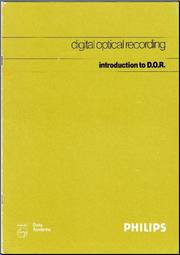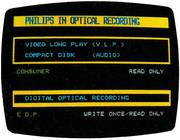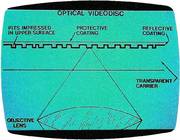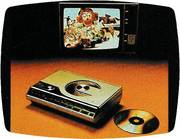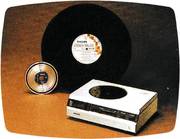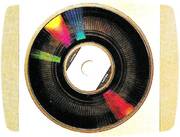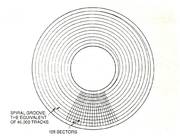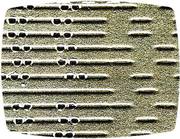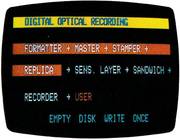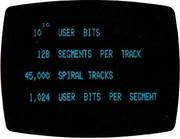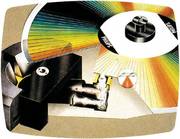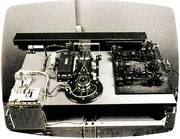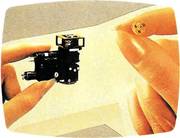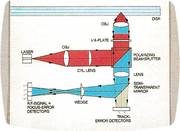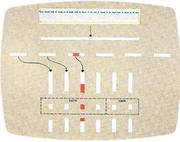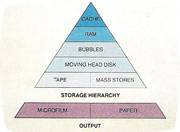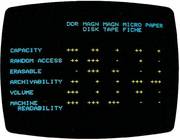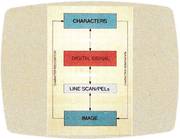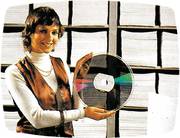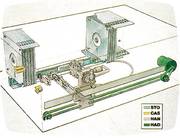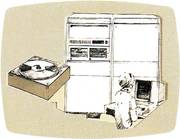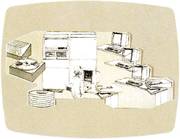Vorbemerkung zu dem Philips Flyer aus 2021:
Im Jahr 1980 war bereits in Fachkreisen bekannt, daß es da eine neue digitale Audio-Schall- platte mit 12cm Durchmesser und einer Laser-Diode als Abtaster geben wird. Auch war in der Presse den Medien aufgefallen, daß Philips sich mit der eigenen bereits in 1972 vorgestellten VLP sehr schwer tat und sie nie mit richtiger Marketing-Power am Markt einführen wollte. Die Hintergründe wurden nie veröffentlicht. Pioneer ist an der Laser-Platte beinahe Pleite gegangen.
Ich vermute, die Ingenieure hatten die Schwachstellen - nämlich das Laser-Rohr - sowohl von der Größe wie auch von der Lebensdauer und dem Stromverbrauch genau gekannt. Jetzt propagiert die Tochterfirma "PHILIPS Data Systems" eine (aber nur einmal) beschreibbare Laser-Disc, die auf der Erfahrung der Entwicklung des CD-Spielers mit der Laserdiode basiert. Auch hier lesen Sie wiederum nur die Sonnenseiten der Medallie. Es gibt kein Wort über die Lebensdauer der Laserdioden, die alleine beim Lesen der Audio-CDs nur ca. 5000 Stunden lang leben. Wie lange die Schreibdioden das durchalten, war in 1980 offensichtlich noch nicht ausprobiert worden.
Kommentar zu den Bildern :
Wir schreiben 1980 und Windows war noch nicht erfunden, das kam erst um 1990. Die ersten Farb-Monitoren in super toller VGA Qualität (640 x 480 Pixel) waren absolut top und damit hat sich der unbekannte Grafiker oder Designer profiliert.
.
1980 - Introduction to D.O.R. ("digital optical recording")
"PHILIPS Data Systems" presents
Philips' way of fast random access to mass data and images
.
Introduction
"Digital Optical Recording" is a new activity of Philips Data Systems. It is a logical consequence of Philips' other activities in optical recording, the consumer audio and video products.
"Digital Optical Recording" (DOR) is the professional side of Philips' optical recording activities in the area of information storage and retrieval.
Many of the principles and production techniques needed for DOR are common to the consumer systems, for which we already progress to mass production with matching reliability. This experience and proven ability are highly relevant for the professional products, as will be shown further on.
The "main application differences"
With many things in common, it is helpful to start with the "main application differences".
In the consumer area, systems be it 12 inch "video long play" (VLP) or 4 inch "compact audio disc" are based on prerecorded disks. These systems only play back, they read but do not write.
Playing back is almost always sequential going from the beginning to the end of a film or record. For information storage and retrieval there is an obvious need for fast, random access.
In the VLP disk reading is done in a similar way to that of a conventional record. A relief pattern is pressed into the disk to form an information track containing the video and audio information.
This is read by the optical systems, but since there is no mechanical contact, the system must also employ optical servo techniques to track along the groove and to stay in focus.
In den USA bereits eingeführt (laut dieser Pressinfor)
Our VLP system is currently being marketed in the United States and will be introduced to Europe in 1981.
It is therefore a thoroughly proven technique and well before our professional systems are on the market, it will have been exhaustively tested in tens of thousands of homes.
Before we leave VLP, I'd like to clear up a point that gives a lot of misunderstanding. This technique is not digital. VLP employs frequency modulation, whereby information is communicated via the length and repetition rate of light pulses.
The compact 4 inch audio disk carries as much information, music or other sound, as a conventional 12 inch long-play record. Reading is done in the same way as VLP. The main difference is that the audio information is digitally encoded.
.
- Anmerkung : Hier beschreibt der Werbetexter eine Version, die so nicht stimmt. Laut anderer Philips Presseinfos wollte oder will Philips die VLP "jetzt doch" und "zuerst in USA" anbieten. Bislang gab es den Philips Bildplatten Spieler nur mit dem Laserrohr, noch nicht mit der Laser-Diode, dier erst 1976 erfunden wurde.
.
The Digital Optical Recording Disk
The 12 inch professional DOR-disk is formed from two glass substrates placed back-to-back in a sealed airtight construction. The so formed disk has a spiral groove (also 1 spiralförmige Rille) that is regarded as the equivalent of 45.000 usable tracks. The disk is also divided into 128 sectors. Each track/sector combination is given an individual segment address. In this way segments can be found in random access mode.
DOR is in principle an empty disk as are magnetic tapes and disks. DOR disks can be written by the user, however only once.
We now take a look at how data are written into the disk. To do this let us examine a single segment and imagine that we can look along it.
At the beginning we would see the address heading, which is a relief pattern pressed into the disk at the manufacturing stage. The dark blue layer symbolises the recording medium which reflects the laser light.
The relief is one quarter of a wavelength deep. Light entering and being reflected back is thus 180 degrees out of phase ... an effect known as interference. The optical system can therefore read the relief pattern as a series of high and low light levels.
.
The disks are preformatted
The empty disks are preformatted in a similar manner as used for VLP. Each DOR sector contains a relief pattern representing the individual address, however there is no prerecording data and the term 'pregrooved' is therefore employed to indicate that beween address headings there is no data, but a shallow groove along which the optics can track and stay in focus.
.
The heading area takes up around 10% of the segment, the rest is available for writing data and it can store up to 128 user bytes. Writing is done by increasing the laser light to a level at which it burns micron-sized holes through the layer, as we see here.
The laser's light escapes through these holes, allowing data to be read by reflection as a series of high and low light levels as shown here. Data is therefore not erasable and via the sandwich construction it has archival qualities.
.
An electron microscope photograph shows the details of the disk surface. The groove indicated by the arrow is empty - here we see the address headings and there is an indication on the photograph of a one micron long white stripe.
From this it is clear that the holes are less than one micron in diameter, allowing a very high areal bit density to be realised.
Production of the professional DOR disks proceeds essentially in the same manner as consumer disks for both VLP and compact audio. As indicated only the last two steps are essentially different. In DOR disks a sensitive layer is fitted to the surface instead of a simple reflective layer. After that a sandwich is formed.
Thus a Digital Optical Disk is formed with a capacity of "10 hoch 10" user bits. This information can be randomly accessed and saved as an archive for more than 10 years.
.
The Digital Optical Recorder (mit Laser-Disode !!)
We have developed a system that uses a semiconductor laser and a 12 inch disk and gives a mean random access time of 135 milliseconds.
If we put that into more meaningful terms, what we're talking about is the equivalent of 500,000 DIN A4 typed pages on this 12 inch disk plus the ability to display a page in a fraction of a second.
In order to do this we had first to find an alternative to the gas laser, which is fine for low power reading, but would be far too heavy and bulky for writing where a much higher energy is required, without employing a complex and impractical system of mirrors.
What we needed was a breakthrough in high-power, solid-state lasers and it came from our own component division Elcoma. With this diode laser we could go on to develop this compact, optical system that is used to concentrate the laser light in a very small spot to generate suitable signals for tracking and focussing to read the address headings and to write and read data.
The optical system, which only weighs 40 grams, is mounted on an arm that is driven by a linear motor. The arm has an optical grating that is used to bring the optics very quickly within 50 tracks of that selected.
Direct reading from the disk then takes over until the correct segment is reached, via track stepping. With this technique the time to go from any track to another track or vice versa is only 100 milliseconds ... so that at the current speed of 16 revolutions per second the latency is 33.3 milliseconds, giving a mean access time to the user data of less than 135 milliseconds.
The schematic shows how the laser light (shown in red) is focussed through the substrate on the bottom surface of the disk. During writing the light level is increased to burn holes in the sensitive layer.
The returning light (shown in blue) is split in two by a semitransparant mirror. Half the light (shown in green) falls on the track error detector, which feeds the tracking servo system. The other half gives the reading and focussing signal.
The performance characteristics of this Digital Optical Recorder are:
- • mean access time of 100 msec. + 33.3 msec, latency
- • data rate 2 M bits/sec.
- • diode laser based
- • 16 revolutions per second
.
Archivability.
Data on the DOR disk are fully protected against dirt, scratches or other external influences. There is no contact between read/write system and the disk, so there is no wear. Moreover the distance between the laser assembly and the disk is sufficiently large (1 millimeter) to prevent head crashes.
After writing the data into the disk the written data are immediately read back into the system and compared with the original data. This is called "Direct Read After Write" (DRAW).
If errors are detected the information is rewritten in the next segment. This feature ensures that the information is error free written into the disk. Because the information is burned into the sensitive layer it cannot be changed afterwards.
We estimate the archival storage life of the information, once written, to be at least ten years without any "refresh".
.
Error correction
The last technical aspect of DOR that we need to consider before
moving onto applications is that of error detection and correction.
Error correction bits are added to the 1024 user bits. This total is split up in code words, which are interleaved throughout the segment. As a result only complete segments are written.
When the information is read at a later date, error bursts are thus distributed over many code words. Standard electronic error-correction techniques are employed which can correct nearly all reading errors. Present day results indicate an error rate of 1012 over 10 years (based on accelerated life time tests).
.
Comparison with existing media (wir sind hier in 1980)
Thus DOR is high-volume, archival-quality storage medium. It therefore does not compete with semi-conductor memories or with magnetic disk systems. In fact just as internal semiconductor CPU memories are complemented by external magnetic disks, so DOR will come to complement magnetic disks.
DOR should be seen as a very viable alternative to magnetic
tape, microfilm and ultimately to paper.
For example:
- - one DOR disk is the equivalent of 35 magnetic tapes (1600 bpi, 2400 feet). For archival storage DOR does not need to be refreshed and unlike tape, it has fast random access to the stored data.
- - if we look at microfilm, we see, that one DOR disk is the equivalent of 500 microfilm COM-fiches and of course the big benefit here is the fact that DOR data stays in machine readable form.
- - one DOR disk is the equivalent of around 500,000 typed DIN A4 pages. This calculation is based on the fact that a 2,500 character A4 page can be stored as a character string of 2 x 104 bits.
.
DOR is not restricted to characters. Images can be scanned and digitised and therefore stored. An A4 image, for example, needs at least ten times more storage capacity than its typed character string equivalent and which demands a correspondingly higher storage capacity, but this is something that is easily affordable with DOR.
DOR can therefore store all types of information ... X-rays, cheques, etc., ... and these can be mixed with character data to give the true electronic equivalent of a filing cabinet ... a highly compact cabinet containing up to 50,000 image A4 pages ... half of which can be found in a fraction of a second, the rest by turning the disk over.
DOR is not limited to one disk. We are currently working on linear selectors that have a mass storage capacity of 64 Gigabytes with an access time of around 10 seconds.
.
Application
We therefore see DOR as the ideal medium for mass storage and for
'office of the future' type applications, which is the topical area of interest to conclude with. Obviously DOR is linked to a computing system to read and write data, but since DOR makes image storage economical, we should really talk about information and not data and extend the concept of processing to include communication.
Once information is in machine readable form it can be stored, retrieved, processed and communicated in virtually whatever way the application demands. We should therefore start by looking at the way information is generated in the office environment and take as our starting point the word processor, which employs electronic processing techniques to prevent entry mistakes-changes and updates to be made.
Once base data is entered and put into machine readable form at this initial stage, it is clear that its use can be extended. Thus instead of filing correct, 'clean' paper copies and identifying the relevant 'floppy disk', in an office of the future typists can simply file it away on DOR via the computer.
They can also use a fraction of the computer's processing power for the word processing function and eliminate the need for specialised, local storage i.e. today's floppies.
Once finished the memory can be erased and used for another purpose because the information is filed in a machine readable form. DOR data can therefore be recalled from file and reprocessed without
ever seeing sight of paper ... the true electronic filing cabinet.
It is clear that via national and international standards such as Teletex, that information can be communicated direct from one system to another to give the much talked about electronic mail. This is done via the data communication facility of the computer.
Information can also be communicated internally via desktop VDU's. In this way management, or whoever, can look at file information without the need to refer to paper or look at the day's electronic mail.
Naturally when paper is required, a print-out can be obtained. But in the office of the future this function will be linked to an 'intelligent copier'. This will function as an output device ... as a regular office copier and also be used to scan character and image information for direct reading into the computer and onto DOR.
We at Philips see in DOR a technology with the potential to meet many forseeable requirements for archival mass storage and high-volume, fast-access information retrieval. Moreover we see a technology firmly based on established manufacturing techniques, yet offering significant performance benefits.
.
Anschriften aus 1980 - (heute ist da niemand mehr)
.
- Federal Republic of Germany
- Philips Data Systems GmbH Weidenauerstrasse 211-213 5900 Siegen 21 Tel. 0271-404337
- The Netherlands
- Philips Data Systems Nederland B.V. Maanweg 156 2516 AB Den Haag Tel. 070-762708
Printed in The Netherlands 8798.702.01811
.
Nachtrag :
Als der Autor Gert Redlich nach seinem Studium 1980 vom Vertrieb in die EDV wechselte, war dieses "DOR" System kein Gesprächsthema. Auch später in 1985 redete niemand von der beschreibbaren Philips Laserdisc zur Datensicherung oder Archivierung. Die ersten QIC Streamer sicherten nämlich bereits 45 Megabyte bis später in 1988 bis zu 512 Megabyte an Daten auf eine QIC 525 Kassette. Ab 1990 gab es die ersten HP DAT Laufwerke mit 2 Gigabyte Kapazität.
.

